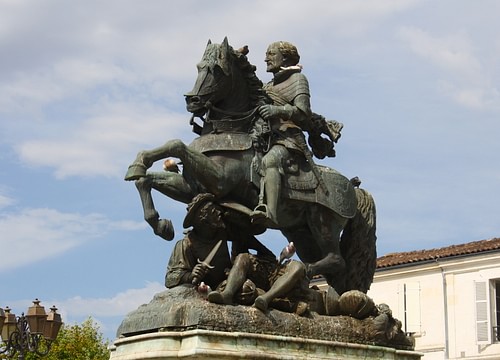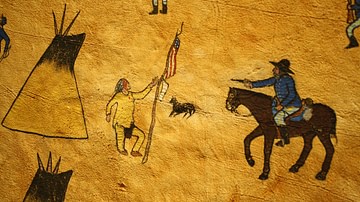As the Reformation developed in France in the first half of the 16th century, there were several episodes of severe repression which preceded the Wars of Religion (1562-1598). These were times of great hardship and oppression against those who embraced Protestant teachings. One notable chapter of persecution took place in the Luberon region of France against the Waldensians (Vaudois), the spiritual descendants of Pierre Waldo, which led to the Mérindol massacre in 1545.

Early Persecution
Early in the 12th century, Pierre Waldo (l. 1140–1218) took a vow of poverty, confirmed by Pope Alexander III (served 1159–1181), and became the leader of a sect known as the Waldensians. Waldo was among the forerunners of the Reformation who sought to purify and reform the Catholic Church from within through a return to apostolic teaching. Initially, he did not seek separation from the Catholic Church or the establishment of a new sect. In time, partly due to their emphasis on preaching the gospel in the local language, Waldo and his followers were banned from preaching by Pope Lucius III (served 1181–1185). Waldo was excommunicated at the Council of Verona in 1184, and Waldensian teaching was condemned at the Fourth Lateran Council in 1215.
Exiled from their city of Lyon, the Waldensians spread to the valleys of Dauphiné and the Alps of Piedmont, to Languedoc, and to Spain. The Inquisition failed to stamp them out and many of the exiles settled in the Luberon region in southern France. The Waldensians sought to live in peace in the sheltered valleys of the Luberon where they drained the swamps and cultivated lands belonging to Italian lords. It is said that people inhabiting the plains feared the Waldensians who had a reputation as sorcerers. At that time, they had spiritual leaders called uncles (barbes) in their language who had authority over the people. The barbes were considered wise and venerable, and mysterious powers were attributed to them. Their brothers in Dauphiné had previously suffered persecution and many had fled to Luberon for safety.
The archbishop of Aix feared that this concentration of heretics might embrace the Reformation. Around 1530, the inquisitor Jean de Roma was sent to investigate the Waldensians where he committed atrocities and enriched himself at their expense. As a result of this initial violence, two Waldensians, Maurel and Masson, crossed the frontiers to Alsace and Switzerland to confer with Reformed leaders in Geneva. They were persuaded of the need to reform their beliefs, to definitively break with superstitious practices, and were sent back with letters for their brothers in Mérindol. Only Maurel arrived home safely; Masson was arrested and burned alive at Dijon. A decisive meeting took place in Piedmont in 1532 with Waldensian leadership from different regions. William Farel (l. 1489–1565), over six days, convinced them to preserve only two sacraments, baptism and the Eucharist, without the mystical sense given by the Catholic Church. Farel welcomed them to the Reformed faith with enthusiasm and called them “the elder sons of the Reformation.”
Papal & Royal Intervention
With their integration into a larger European movement, the Waldensians no longer felt isolated. They welcomed all who sought refuge in their mountains, in particular former Catholic priests who were valued for their literacy. Fearing that the new religion would propagate to the papal enclave of Venaissin, Pope Clement VII (served 1523–1534) offered a plenary indulgence to Waldensians who renounced their Reformed faith within two months. During the waiting period, his soldiers seized women and children to convert them forcibly, and young women were abducted in the village of Cabrières-du-Comtat. Their fathers, armed with clubs and pitchforks, were no match for trained soldiers and were stopped without difficulty. The news of the abductions and armed encounter circulated throughout the village. A mob emerged leading to the death of officials in Agoult and Apt. The pope wrote King Francis I (r. 1515–1547) to report the violence taking place at the door of papal states. The king gave instructions to the Parliament at Aix to intervene and seven Waldensians were burned at the stake, including one barbe.
The intervention of the king had the effect of pushing communities to revolt. It is estimated that about 6,000 men belonged to the Waldensian sect at this time, and the bishops of Sisteron, Apt, and Cavaillon feared the spread of the movement throughout Provence. Members of the sect were pursued and arrested because they denied purgatory, did not pray to the saints, and refused to pay the tithe to the clergy. The most active Waldensians were imprisoned and some were executed. Infuriated by the actions of ecclesiastical tribunals, the Waldensians took up arms to liberate their brothers and assaulted prisons in Apt, Cavaillon, and Roussillon. The king, informed of these events, offered clemency to the heretics and the release of all not-yet-liberated prisoners on the condition that they renounce their faith within six months. Yet no one accepted his proposition and in 1538 the king ordered the arrest of heretics and the confiscation of their possessions.
Rumors & Arrests
Rumors reached the Parliament in Aix that the Waldensians were preparing for a siege and had stored stocks of powder and arms. Over 150 Waldensians were arrested, 14 of them from Mérindol. A judge in Apt proceeded to arrest a miller and confiscated his mill after his execution. The inhabitants of Mérindol retaliated by taking up arms, burning the mill to the ground, pillaging farms, and stealing sheep along the way. Nineteen more residents of Mérindol were designated for arrest, some with their families, based on anonymous denunciations. As a climate of panic reigned in Aix, more unsubstantiated rumors circulated that the Waldensians were building forts in the forests and that there were 600 men in Mérindol armed with arquebuses, a type of long gun. The exaggerated total number swelled to 8,000 combatants. Soon after, the arrest order was given which included the seizure of pregnant women. But before it was carried out, the parliamentarians realized they had been duped by local leaders. In reality, the Mérindoliens had fled to their mountains to avoid arrest after learning that on 18 November 1540 an order had been given condemning 19 of them to be burned at the stake in three different places—Tourves, Apt, and Aix. Houses in Mérindol would be demolished, the area rendered uninhabitable, and their possessions confiscated.
Temporary Reprieve
Farel was warned by courier of the order and contacted Swiss and German cities to intercede diplomatically with Francis I. The king charged the governor of Piedmont, Guillaume du Ballay, to investigate the Waldensians. When he delivered a favorable report, the king suspended the order and demanded the appearance of the Waldensian elders before the Parliament within three months. Persecution was taking place throughout the kingdom and the king could not afford to handle the Waldensians lightly. Instead of sending the elders before the Parliament to renounce their faith, on 6 April 1541 the Mérindoliens sent their barbes to explain their faith in Jesus Christ and the Scriptures, and to affirm their spirit of obedience to civil authorities. They were willing to submit to all laws but requested that they be allowed to practice their faith. The unyielding parliamentarians denounced the audacity of this supplication and the reaffirmation of the Waldensians’ articles of faith. The king granted another three-month delay and the Parliament sent the bishop of Cavaillon to Mérindol to receive their renouncement on the spot.
After further delays and the refusal of renouncement, the king finally resolved in March 1543 to carry out the order against Mérindol. Once again, German Protestant princes, urged by Farel and Calvin, intervened with the king. In April 1544, the Waldensians presented a petition to the king to obtain justice from those who reproached their faith with the intent to confiscate their possessions. The king was aware of the avarice of the bishops and papal legates, and also knew that the parliamentarians of Aix were not above reproach. He was also hesitant to send military forces to a far-flung province. So he decided to send three members of his council and a theologian to establish whether the Waldensians were heretics. If found to be heretics, they would be granted another two months to renounce their faith. The Parliament of Aix was ordered to relinquish its responsibilities to the Parliament of Grenoble. As a result, the Waldensians sensed that the king hesitated to employ force against them and would defend them from the cupidity of the princes of the Church. Many refugees flocked to the Waldensian valleys to find shelter from persecution. Those in Geneva even thought that they had turned back the royal power. For a time at least!
Vain Resistance
In December 1543 Jean Meynier (l. 1495–1558) replaced Chassané as president of the Parliament of Aix. He had sworn to obtain the revocation of the letters of pardon and to annihilate the Waldensians. Cardinal Francis de Tournon, a declared enemy of heresy, agreed. The local governor confirmed the report of Meynier that the Waldensians had a force of 10,000 armed men ready to march on Marseille. The Waldensians, with little confidence in the seigneurs of Aix and Avignon, fortified their villages, notably Cabrières. The king signed an order on 1 January 1545, ostensibly without reading it, revoking the pardon he had granted. Persecution in France resumed with burning stakes at Toulouse, Bordeaux, and Grenoble. Meynier kept the text hidden from his parliamentarian colleagues while awaiting the arrival in Provence of a captain from Italy, Paulin de La Garde (l. 1498–1578). He was the leader of a fearful band of roving mercenaries who had fought under Francis I. Once he arrived, the Parliament gave the order to proceed to the total annihilation of the heretics.
La Garde marched on Cabrières-d’Aygues where 600 Waldensians were reportedly gathered. The Waldensians fled and left La Garde wondering why he had been called to employ his army against feeble villagers. At Cadenet, army and Parliament leaders from Aix agreed to seize the heretics and burn their houses as an example to others. La Garde’s men were professional soldiers, joined by troops gathered by Meynier and by volunteers eager to profit from the plunder. The inhabitants of Mérindol fled to the Luberon forests while 200 farms were burned. Hidden in the ravines, the villagers learned that the army had entered Mérindol and watched it burn from a distance. The men mounted upward and joined their brothers in the villages of La Coste and Cabrières-du-Comtat. In the fortified village of Cabrières, they decided to stand and resist with 300 Waldensian combatants.
In the ensuing combat, there were many dead and wounded on both sides. Led by Marron, the Waldensians did their best but were not equal to the task of resisting the cannons of the enemy. They proposed to open the gates if promised safe passage to Germany or if given a pledge of fair trials. With the promise received, Marron and his partisans exited the village first. They were immediately seized and executed in a nearby meadow. Only Marron and the pastor Guillaume Serre were spared, taken in custody by the pope’s legate to Avignon to be judged and burned alive. The female combatants were locked up in a barn which was then set ablaze. Those who tried to escape were massacred, their heads carried in triumph on the tips of lances. Soldiers searched for survivors and forced open the door of the church. In the sanctuary women were raped, their throats slit, and some thrown from the bell tower. The few women who survived were sold as slaves at L’Isle-sur-le-Sorgue. In one month, 900 houses were burned, 24 villages destroyed, and 3,000 people massacred. Only the most robust men were spared and sold to spend their remaining days on the king’s galley ships. The Parliament made it a crime to assist those in misery dying from hunger. Anyone showing pity suffered the confiscation of their possessions. The cavalry of Agoult, installed at the Tour-d’Aigues, roamed throughout the countryside committing atrocities. Peasants were forced to travel to Aix or Marseille to find and ransom their kidnapped children. When the Parliament sent two members to investigate the barbarism, they returned horrified. The peasants of Luberon could no longer work their land without soldiers stealing their oxen and women were robbed in the fields. Based on this report, the Parliament rendered a new order authorizing the authorities to assist the population.
Coverup & Controversy
The king ordered an investigation and demanded an accounting of the expedition. De Tournon supported the cause of Meynier and on 8 August 1545 the king rendered his verdict, approving what was done to exterminate the Waldensians. Calvin and Farel were devastated by the news and requested intervention from the Swiss. The king’s justification to the Swiss was that the Waldensians were disloyal subjects and punished because they refused to pay the tithe. At the death of Francis I the tide turned. Meynier sought to continue the persecution and arrested two men with strong connections in Parliament. De Tournon was in a state of disgrace with King Henry II of France (r. 1547–1559) who designated a commission to investigate Meynier and others involved in the crimes. The indictment against Meynier charged him with distorting the truth about the heretics, undertaking the massacres on his initiative, and condemning the vagabonds to die of hunger. His eloquence allowed him to save his head and he expressed no remorse for his actions against the Waldensians. In the end, Jean Meynier was liberated, restored to his functions, and named chevalier of Saint-Jean-de-Latran by the pope.
Conclusion
What became of the Waldensians? Some escaped to Geneva where they were well received. Others found refuge in communities in Dauphiné. In any case, they powerfully aided the Reformed cause in gaining a foothold in the Cévennes and Languedoc. Several years later, Sébastian Castellion (l. 1515–1564), who ministered alongside Calvin for a time in Geneva, wrote in the preface to his Traité des hérétiques, “Who would want to become a Christian when they see that those who confess the name of Christ are bruised at the hands of Christians, by fire, by water, by the sword, and treated more cruelly than robbers and murderers?”










